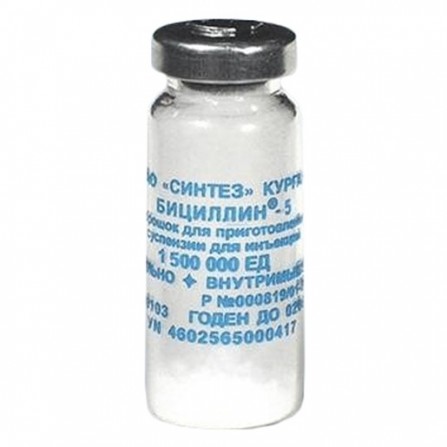Bicillin-5 powder for preparing a suspension of 1.5 million units
Condition: New product
1000 Items
Rating:
Be the first to write a review!

More info
Active ingredients
Benzatine benzylpenicillin
Release form
Powder
Composition
1 vial with a capacity of 10 ml (Bicillin-5) with powder for preparing injection solution for intramuscular injection contains: benzylpenicillin benzathine 1,200,000 U and benzylpenicillin novocaine salt 300,000 U.
Pharmacological effect
Combined bactericidal antibiotic consisting of two salts of benzylpenicillin long-acting. Suppresses the synthesis of the cell wall of the microorganism. Active against gram-positive microorganisms: Staphylococcus spp. (non-educational penicillinase), Streptococcus spp. (including Streptococcus pneumoniae), Corynebacterium diphtheriae, anaerobic spore-forming rods, Bacillus anthracis, Clostridium spp., Actinomyces israelii; Gram-negative microorganisms: Neisseria gonorrhoeae, Neisseria meningitidis, Treponema spp. The action of the drug resistant strains of Staphylococcus spp., Producing penicillinase.
Pharmacokinetics
Bicillin-5 is a drug of prolonged action, the high concentration of the antibiotic in the blood lasts up to 4 weeks. Benzatine Benzyl Penicillin: After an intramuscular injection of benzathine, Benzyl Penicillin hydrolyzes very slowly, releasing Benzyl Penicillin. The maximum concentration of the drug in serum is reached 12-24 hours after injection. The long half-life provides a stable and long-term concentration of the drug in the blood: on day 14 after elimination of 2,400,000 IU of the drug, the serum concentration is 0.12 μg / ml; on the 21st day after administration of 1200000 IU of the drug - 0.06 mcg / ml (1 IU = 0.6 mcg). Diffusion of the drug in the liquid is complete, diffusion in the tissue is very weak. Communication with plasma proteins 40-60%. Benzatine benzylpenicillin passes in small quantities through the placental barrier, and also penetrates into the mother's breast milk. Biotransformation of the drug is insignificant. Excreted mainly by the kidneys in unchanged form. For 8 days allocated up to 33% of the administered dose. Benzylpenicillin: The maximum concentration in plasma with intramuscular administration is reached in 20-30 minutes. The half-life of the drug is 30-60 minutes, with renal failure 4-10 hours or more. Communication with plasma proteins - 60%. Penetrates organs, tissues and biological fluids, except for cerebrospinal fluid, eye tissue and prostate gland. When inflammation of the meningeal sheath penetrates the blood-brain barrier. It passes through the placenta and penetrates into breast milk. Excreted by the kidneys unchanged.
Indications
Infectious diseases caused by microorganisms sensitive to the drug (especially if it is necessary to maintain a therapeutic concentration for a long time), including acute tonsillitis, scarlet fever, wound infections, erysipelas. rheumatism (prevention and treatment) caused by treponema (syphilis, yaws), leishmaniasis.
Contraindications
Hypersensitivity, (including to other penicillins and components of the drug). With care, bronchial asthma, pollinosis, urticaria and other allergic diseases. hypersensitivity to various drugs, including to antibiotics and sulfonamides (in history).
Precautionary measures
With care: pregnancy, renal failure, aggravated allergic anamnesis, bronchial asthma, pseudomembranous colitis.
Use during pregnancy and lactation
Bicillin-5 in small amounts penetrates through the placental barrier and into the mother's milk. Use during pregnancy is possible only when the intended benefit to the mother outweighs the potential risk to the fetus. It is recommended to stop breastfeeding, if necessary, the appointment of the drug.
Dosage and administration
Bicillin-5 for adults - 1.5 million IU once every 4 weeks, children up to 8 years old - 600000 IU once every 3 weeks, children over 8 years old - 1.2–1.5 million IU every 4 weeks. The suspension is prepared under aseptic conditions immediately before use (in a vial containing 1.5 million U, inject 5–6 ml of sterile distilled water, 0.9% sodium chloride solution or 0.25–0.5% novocaine solution). The mixture in the vial is shaken for 30 s in the direction of the longitudinal axis until a homogeneous suspension (or suspension) is formed and immediately injected.
Side effects
Cardio-vascular system and blood (blood, hemostasis), anemia, thrombocytopenia, leukopenia, gipokoagulyatsiya.Allergicheskie reaction rash on the skin and mucous membranes, rash, eosinophilia, joint pain, erythema multiforme, exfoliative dermatitis, angioedema, anaphylactic shock. Other headache, fever, arthralgia, stomatitis, glossitis, soreness at the injection site. with long-term therapy, superinfection caused by drug-resistant microorganisms and fungi.
Interaction with other drugs
Bactericidal antibiotics (includingcephalosporins, vancomycin, rifampicin, aminoglycosides) have a synergistic effect; bacteriostatic (including macrolides, chloramphenicol, linkosamides, tetracyclines) - antagonistic. Increases the effectiveness of indirect anticoagulants (suppressing the intestinal microflora, reduces the prothrombin index); reduces the effectiveness of oral contraceptives, drugs, in the process of metabolism of which para-aminobenzoic acid is formed, ethinyl estradiol - the risk of breakthrough bleeding. Diuretics, allopurinol, tubular secretion blockers, phenylbutazone, NSAIDs, reducing tubular secretion, increase the concentration of benzylpenicillin in the blood and tissues. Allopurinol increases the risk of allergic reactions (skin rash).
special instructions
It can not be administered subcutaneously, intravenously, endolyumbno, as well as in the body cavity. In case of an accidental intravascular injection, a transient feeling of depression, anxiety and visual impairment (Uanier syndrome) may occur. In order to avoid accidental intravascular injection of the drug, it is recommended to perform an aspiration before intramuscular injection in order to identify possible needle penetration into the vessel. When treating syphilis, before starting therapy and then for 4 months, microscopic and serological studies are necessary. In connection with the development of fungal infections, it is advisable to simultaneously prescribe vitamins of group B and vitamin C, and, if necessary, antifungal drugs for systemic use. It must be borne in mind that the use of insufficient doses or too early discontinuation of treatment often leads to the emergence of resistant strains of pathogens.



